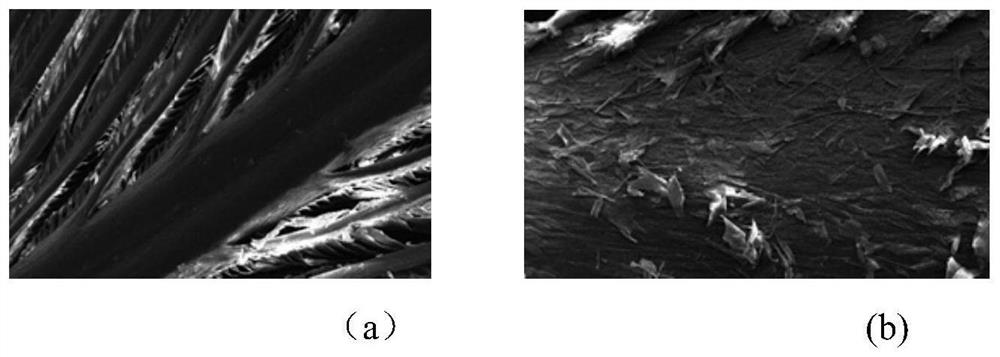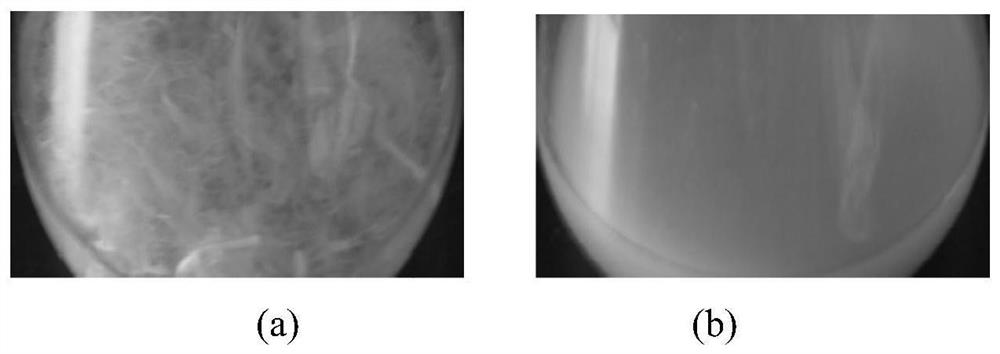A kind of bacillus subtilis and application thereof
A technology of Bacillus subtilis and seeds, applied in the field of Bacillus subtilis and its application, can solve the problems of insufficient utilization and achieve the effects of fast growth, easy availability of ingredients, and good ability to degrade waste protein
- Summary
- Abstract
- Description
- Claims
- Application Information
AI Technical Summary
Problems solved by technology
Method used
Image
Examples
Embodiment 1
[0035] A method for Bacillus subtilis to degrade keratin, specifically as follows:
[0036] (1) Preparation of seed medium: Each liter of seed medium contains 10 g of peptone, 5 g of beef extract, 3 g of sodium chloride, pH 7.0, sterilized at 121° C. for 20 minutes, and then cooled to room temperature for use.
[0037] (2) Inoculate 1 loop of Bacillus subtilis on the slant into the seed medium, and cultivate at 30° C. at a temperature of 150 rpm for 16 hours to the logarithmic growth phase to obtain a seed solution;
[0038] (3) Preparation of fermentation medium, each liter of fermentation medium contains 20 g of poultry feathers, 3 g of potassium dihydrogen phosphate, 1.5 g of dipotassium hydrogen phosphate, 1 g of magnesium sulfate, 1 g of sodium chloride, pH 7.0, and the medium is sterilized at 115 ° C. Cool for 30 minutes and set aside.
[0039] (4) Inoculate the seed solution obtained in step (2) into the fermentation medium of step (3) at a ratio of 3% by volume, and c...
Embodiment 2
[0044] A method for Bacillus subtilis to degrade keratin, specifically as follows:
[0045] (1) Preparation of seed medium: Each liter of seed medium contains 15g of peptone, 6g of beef extract, 3g of sodium chloride, pH 7.2, sterilized at 121°C for 20 minutes and then cooled to room temperature for use.
[0046] (2) Inoculate one loop of Bacillus subtilis on the slant into the seed culture medium, and cultivate at 37° C. and 200 rpm for 20 hours to logarithmic growth phase to obtain seed liquid.
[0047] (3) Prepare fermentation medium: every liter of fermentation medium contains pig hair powder 20g, potassium dihydrogen phosphate 2.5g, dipotassium hydrogen phosphate 1.0g, magnesium sulfate 1g, sodium chloride 2g, pH value 7.2, culture medium after 121 After sterilizing at ℃ for 20 minutes, cool down for later use.
[0048] (4) Inoculate the seed liquid obtained in step (2) into the fermentation medium of step (3) at a ratio of 5% by volume, and cultivate it at 37°C for 60 h...
Embodiment 3
[0053] A method utilizing bacillus subtilis to degrade keratin, the specific steps are as follows:
[0054] (1) Preparation of seed medium: Each liter of seed medium contains 5 g of peptone, 8 g of beef extract, 4 g of sodium chloride, pH 6, sterilized at 121° C. for 20 minutes, and then cooled to room temperature for use.
[0055] (2) Inoculate one ring of Bacillus subtilis on the slant into the seed culture medium, and cultivate at 37° C. and 220 rpm for 10 hours to obtain a seed solution.
[0056] (3) Preparation of fermentation medium: every liter of fermentation medium contains 20g of feathers, 6.0g of potassium dihydrogen phosphate, 5.0g of dipotassium hydrogen phosphate, 3.0g of magnesium sulfate, 1g of sodium chloride, pH 8.5, and the medium is heated at 121°C Cool for 20 minutes after sterilization.
[0057] (4) Inoculate the seed solution obtained in step (2) into the fermentation medium of step (3) at a ratio of 6%, and cultivate it for 20 hours at a temperature of...
PUM
 Login to View More
Login to View More Abstract
Description
Claims
Application Information
 Login to View More
Login to View More - R&D
- Intellectual Property
- Life Sciences
- Materials
- Tech Scout
- Unparalleled Data Quality
- Higher Quality Content
- 60% Fewer Hallucinations
Browse by: Latest US Patents, China's latest patents, Technical Efficacy Thesaurus, Application Domain, Technology Topic, Popular Technical Reports.
© 2025 PatSnap. All rights reserved.Legal|Privacy policy|Modern Slavery Act Transparency Statement|Sitemap|About US| Contact US: help@patsnap.com



